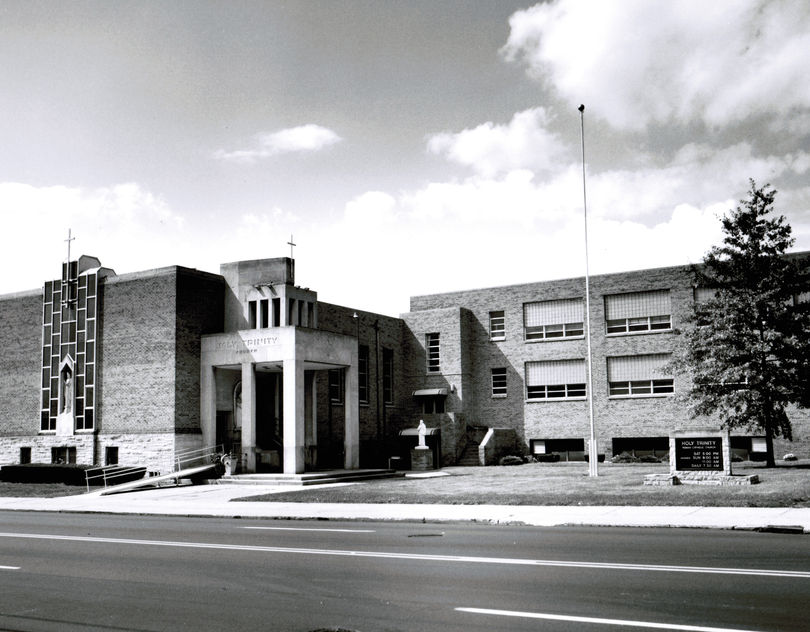
HOLY TRINITY PARISH, BARBERTON, 1911
Around 1900, a decade after C. Barber, the founder of the Diamond Match Company, settled in the area, the first Hungarian-Catholic families arrived in Barberton, Ohio. John and Catherine Szemon and their children came to Barberton and opened a tavern on Wolf Street, where area workers came to socialize. When a Hungarian priest was in the area, the community also celebrated Mass there. The fledgling Hungarian community soon established a number of mutual aid societies. In 1907, seven Hungarian women, recognizing the potential disaster brought on by illness or injury, established the Saint Elizabeth Sick Aid Society.
Two years later, the community organized the Barberton Branch of the Saint Stephen Society—the predecessor of the American Hungarian Catholic Society. These two societies were joined by a third organization, the Saint Joseph Society, in July 1910. At its January 1, 1911 meeting, the Saint Joseph Society proposed purchasing the former German Lutheran church on First Street N. W. With the financial assistance of the Saint Elizabeth and Saint Stephen Societies, a seven-member delegation from the Saint Joseph Society made an initial payment on the church on January 21, 1911. Eight days later, Barberton's Hungarian-Catholics met to elect officers of the new church.
Still too small to support a pastor, the community welcomed a number of visiting priests, including Father Oscar Szilagyi, Father Emil Egner, Father Oscar Solymos, and Father Peter Popovich (a Greek-Catholic Priest), Father Francis Denes, and Father Nador Pupinsky. Father Denes later returned to Barberton, this time as the first pastor of the newly formed Holy Trinity Parish. His pastorate, however, was short-lived, as he soon returned to Hungary. Recognizing the commitment of Barberton's Hungarian-Catholic community, Bishop Joseph Schrembs searched for a second pastor, finally selecting Father Joseph Toth, OFM. Father Toth ministered to the spiritual needs of the community until the spring of 1924, when fellow Franciscan, Father Lawrence Biro from Erdely, Hungary arrived in Barberton. Recognizing the inadequacies of the first Holy Trinity Church, Father Biro turned to his parishioners with a proposal for a new church. The next month, the Saint Stephen Society presented the first Hungarian play in Barberton, the first in a series of performances, the proceeds from which were used to establish a building fund for the new church. Father Biro, however, did not see the completion of the project, being transferred to South Bend, Indiana in April 1927. His successor, Father Athanasius Kovacs, assured the parish he would complete the work begun by Father Biro.
On July 1, 1928, the parish purchased land for the new church and school on Wooster Road North. With the onset of the Great Depression, however, money became scarce, and work on the building was postponed until September 1932. By Passion Sunday 1933, the building had progressed sufficiently to allow the parish to celebrate its first Mass in the basement of the church. On May 30, 1933, Auxiliary Bishop James A. McFadden dedicated the new Holy Trinity Church. It was in this basement church that the community endured the trying times of the Great Depression, the Second World War, and the rise of the Cold War's Iron Curtain. After serving the Holy Trinity community for over 25 years, Father Kovacs died of cancer on December 28, 1952.
The parish's next pastor, Father Nicholas Dengl, OFM, received permission from Archbishop Edward F. Hoban to complete the church. In August 1959, Father Dengl celebrated Mass for the first time in the upper church. That same year, Holy Trinity School opened with three Sisters of the Divine Redeemer from Elizabeth, Pennsylvania and one lay teacher. On December 13, 1959, the new Holy Trinity Church was dedicated. Upon Father Dengl's 1964 elevation to Custos of the Franciscan Order in Youngstown, Ohio, the parish welcomed a new pastor, Father Baan Vitez, OFM. During Father Vitez's pastorate, the parish constructed a new brick convent, remodeled the church sanctuary to comply with the reforms of the Second Vatican Council, and installed new stained-glass windows in the front of the church. In 1973, Father Vitez left the parish.
During the pastorate of his successor, Father George Meszaros, OFM, the parish addressed its growing financial problems. On May 30, 1974, Holy Trinity Parish was honored with a visit from Cardinal Joseph Mindszenty, advocate for religious and political rights, who had been imprisoned by Hungary's Communist government.. Departing in June 1976, Father Meszaros left the community in the capable hands of Fathers Nicholas Dengl, OFM and Carl Ciprian, OFM, who together worked towards the retirement of the parish debt. During the early 1980s, the parish welcomed a number of pastors, including Fathers John Domotor, OFM, Father Charles Reuter, OFM, and Father Kalman Miskolczy, OFM. In 1983, Father Cipran returned to the parish. With its enrollment, dropping, Holy Trinity School closed in June 1986. In this sesquicentennial year, the Holy Trinity Parish continues to uphold the religious and social traditions of its Hungarian-Catholic founders.


